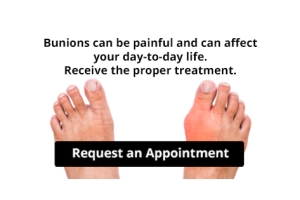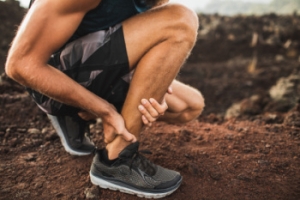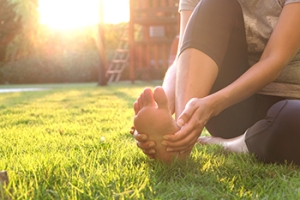Connect With Us

Common Running Injuries and Treatment
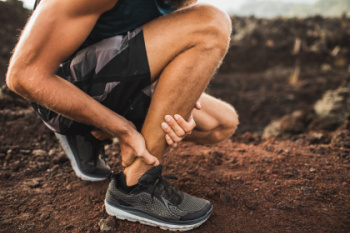 Common running injuries include shin splints, Achilles tendinitis, plantar fasciitis, and stress fractures. Shin splints cause pain along the shin bone due to overuse or wearing improper footwear. Achilles tendinitis involves inflammation of the Achilles tendon, while plantar fasciitis affects the band of tissue that connects the heel to the toes, causing heel pain. Stress fractures are tiny cracks in bones due to repetitive force. Evaluation involves a physical examination, imaging tests like X-rays or MRI scans, and a review of the runner's history and habits. Prevention includes proper warm-ups, wearing appropriate shoes, gradually increasing running intensity, and incorporating strength and flexibility training. Treatment varies but often includes rest, compression, elevation, gentle stretching, and sometimes anti-inflammatory medications or orthotics. If you are a runner who has sustained an injury to your feet or ankles, it is suggested that you schedule an appointment with a podiatrist for a proper diagnosis and treatment.
Common running injuries include shin splints, Achilles tendinitis, plantar fasciitis, and stress fractures. Shin splints cause pain along the shin bone due to overuse or wearing improper footwear. Achilles tendinitis involves inflammation of the Achilles tendon, while plantar fasciitis affects the band of tissue that connects the heel to the toes, causing heel pain. Stress fractures are tiny cracks in bones due to repetitive force. Evaluation involves a physical examination, imaging tests like X-rays or MRI scans, and a review of the runner's history and habits. Prevention includes proper warm-ups, wearing appropriate shoes, gradually increasing running intensity, and incorporating strength and flexibility training. Treatment varies but often includes rest, compression, elevation, gentle stretching, and sometimes anti-inflammatory medications or orthotics. If you are a runner who has sustained an injury to your feet or ankles, it is suggested that you schedule an appointment with a podiatrist for a proper diagnosis and treatment.
Sports related foot and ankle injuries require proper treatment before players can go back to their regular routines. For more information, contact Dr. Michael D. Garvin of Florida. Our doctor can provide the care you need to keep you pain-free and on your feet.
Sports Related Foot and Ankle Injuries
Foot and ankle injuries are a common occurrence when it comes to athletes of any sport. While many athletes dismiss the initial aches and pains, the truth is that ignoring potential foot and ankle injuries can lead to serious problems. As athletes continue to place pressure and strain the area further, a mild injury can turn into something as serious as a rupture and may lead to a permanent disability. There are many factors that contribute to sports related foot and ankle injuries, which include failure to warm up properly, not providing support or wearing bad footwear. Common injuries and conditions athletes face, including:
- Plantar Fasciitis
- Plantar Fasciosis
- Achilles Tendinitis
- Achilles Tendon Rupture
- Ankle Sprains
Sports related injuries are commonly treated using the RICE method. This includes rest, applying ice to the injured area, compression and elevating the ankle. More serious sprains and injuries may require surgery, which could include arthroscopic and reconstructive surgery. Rehabilitation and therapy may also be required in order to get any recovering athlete to become fully functional again. Any unusual aches and pains an athlete sustains must be evaluated by a licensed, reputable medical professional.
If you have any questions please feel free to contact our offices located in Port St. Lucie, FL . We offer the newest diagnostic and treatment technologies for all your foot and ankle needs.
Sports Related Foot and Ankle Injuries
Foot and ankle injuries are common among athletes and those who exercise frequently. Most of these injuries are non-life-threatening and can heal in weeks with proper treatment and care. Serious injuries, however, require urgent medical treatment.
Common minor injuries include ankle sprains, ankle strains, Achilles tendonitis, plantar fasciitis, stress fractures, and turf toe. An ankle sprain is when the ligaments in the ankle have either become stretched or torn. When the muscle or tendon is stretched or torn, it is an ankle strain. When the big toe is sprained, it is known as turf toe. Achilles tendonitis is the overuse and inflammation of the Achilles tendon. Plantar fasciitis is the inflammation of the plantar fascia and generally occurs from overuse in athletics. Stress fractures are also caused from overuse and are small cracks in the bone.
Achilles tendon ruptures are common, but more serious. This injury occurs when the Achilles tendon, the largest tendon in the body, ruptures. In most cases, this causes severe pain and difficulty walking; some who have experienced this injury have reported, however, no signs or symptoms. A laceration is a deep cut that can occur anywhere on the body. Lacerations on the foot are rarer, but can occur from things like metal cleats landing on the foot.
Treatment options cover a wide range of methods based upon the injury and its severity. Conditions like plantar fasciitis, stress fractures, Achilles tendonitis, turf toe and ankle sprains/ strains can heal on their own without immediate medical care, but seeing a podiatrist to monitor the injury is always recommended. Following the RICE (Rest, Icing, Compression, and Elevation) protocol is generally enough to treat minor injuries. This means resting the foot by either keeping pressure off the foot or not walking at all. Icing the injury will help reduce swelling and pain. Compressing the wound with a wrap will immobilize and help promote healing. Finally, keeping the wound elevated will also reduce swelling and also help the healing process.
It is important to note that even minor injuries can vary in severity, with grade one being a minor injury and grade three requiring urgent care by a podiatrist. Achilles tendon ruptures and lacerations on the foot generally require urgent medical care and treatment options that need a podiatrist. These could include imaging tests, stitches for cuts, rehabilitation, and casts or braces. Every case is different, however, so it is always recommended to see a podiatrist when pain in the foot does not disappear.
Exploring the Causes of Foot and Ankle Pain
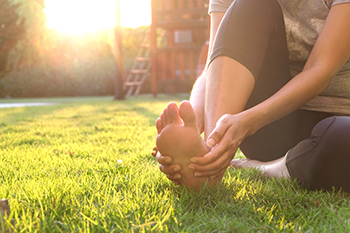
Foot and ankle pain can stem from a variety of sources, each with its unique challenges. Bruises often result from direct trauma, causing discoloration and tenderness. Puncture wounds, which may occur from stepping on sharp objects, can lead to infection if not properly treated. Injuries to ligaments and tendons, such as sprains and strains, are common, and typically result from overuse or sudden twists and turns, leading to swelling and pain. Dislocations, though less frequent, can occur from severe trauma, necessitating medical intervention to realign the bones. Retrocalcaneal bursitis, an inflammation of the bursa located at the back of the heel, often arises from repetitive stress or ill-fitting shoes, causing pain and swelling near the Achilles tendon. Addressing foot and ankle pain effectively requires identifying the specific cause and implementing appropriate treatments. If you have any type of foot or ankle pain, it is suggested that you are under the care of a podiatrist who can offer you effective treatment options.
Foot Pain
Foot pain can be extremely painful and debilitating. If you have a foot pain, consult with Dr. Michael D. Garvin from Florida. Our doctor will assess your condition and provide you with quality foot and ankle treatment.
Causes
Foot pain is a very broad condition that could be caused by one or more ailments. The most common include:
- Bunions
- Hammertoes
- Plantar Fasciitis
- Bone Spurs
- Corns
- Tarsal Tunnel Syndrome
- Ingrown Toenails
- Arthritis (such as Gout, Rheumatoid, and Osteoarthritis)
- Flat Feet
- Injury (from stress fractures, broken toe, foot, ankle, Achilles tendon ruptures, and sprains)
- And more
Diagnosis
To figure out the cause of foot pain, podiatrists utilize several different methods. This can range from simple visual inspections and sensation tests to X-rays and MRI scans. Prior medical history, family medical history, and any recent physical traumatic events will all be taken into consideration for a proper diagnosis.
Treatment
Treatment depends upon the cause of the foot pain. Whether it is resting, staying off the foot, or having surgery; podiatrists have a number of treatment options available for foot pain.
If you have any questions, please feel free to contact our offices located in Port St. Lucie, FL . We offer the newest diagnostic and treatment technologies for all your foot care needs.
Foot Pain
The feet, being the foundation of the body, carry all of the body’s weight and are therefore prone to experiencing pain and discomfort. If you are experiencing foot pain, it is important to determine where in the foot you are experiencing this pain to help discover the cause of it. While pain can be experienced virtually anywhere in the foot, the most common sites of foot pain are in the heel and ankle.
Heel pain can be due to a multitude of conditions including plantar fasciitis, Achilles tendinitis, and heel spurs. Pain experienced in the ankle can be a sign of an ankle sprain, arthritis, gout, ankle instability, ankle fracture, or nerve compression. In more serious cases, pain in the foot can be a sign of improper alignment or an infection.
Foot pain can be accompanied by symptoms including redness, swelling, stiffness and warmth in the affected area. Whether the pain can be described as sharp or dull depends on the foot condition behind it. It is important to visit your local podiatrist if your foot pain and its accompanying symptoms persist and do not improve over time.
Depending on the location and condition of your foot pain, your podiatrist may prescribe certain treatments. These treatments can include but are not limited to prescription or over-the-counter drugs and medications, certain therapies, cortisone injections, or surgery.
If you are experiencing persistent foot pain, it is important to consult with your foot and ankle doctor to determine the cause and location. He or she will then prescribe the best treatment for you. While milder cases of foot pain may respond well to rest and at-home treatments, more serious cases may take some time to fully recover.
Finding Running Shoes for Your Child

Finding the perfect pair of running shoes for your child involves more than just picking the trendiest style off the shelf. It's about ensuring that their feet are properly supported and protected, especially during their active play and sports activities. Look for features, such as arch support, a shock-absorbing sole, firm heel support, and easy-to-fasten closures like laces or Velcro. Prioritize fit by having your child's feet measured for both length and width, and make sure they try on several pairs to find the best match for their foot shape. Remember that shoe sizes can vary between brands, so focus on how the shoe feels rather than the number on the label. Pay attention to details like toe wiggle room, snug yet comfortable heel fit, and proper alignment of the ball of the foot. And don't forget, a good shoe should feel comfortable right from the start. There shouldn't be a need to break them in. If you're unsure about the fit or need help with a specific foot problem, it is suggested that you make an appointment with a podiatrist who can offer tailored recommendations based on your child's specific needs.
Making sure that your children maintain good foot health is very important as they grow. If you have any questions, contact Dr. Michael D. Garvin of Florida. Our doctor can provide the care you need to keep you pain-free and on your feet.
Keeping Children's Feet Healthy
Having healthy feet during childhood can help prevent medical problems later in life, namely in the back and legs. As children grow, their feet require different types of care. Here are some things to consider...
Although babies do not walk yet, it is still very important to take care of their feet.
Avoid putting tight shoes or socks on his or her feet.
Allow the baby to stretch and kick his or her feet to feel comfortable.
As a toddler, kids are now on the move and begin to develop differently. At this age, toddlers are getting a feel for walking, so don’t be alarmed if your toddler is unsteady or ‘walks funny’.
As your child gets older, it is important to teach them how to take care of their feet.
Show them proper hygiene to prevent infections such as fungus.
Be watchful for any pain or injury.
Have all injuries checked by a doctor as soon as possible.
Comfortable, protective shoes should always be worn, especially at play.
If you have any questions please feel free to contact our offices located in Port St. Lucie, FL . We offer the newest diagnostic and treatment technologies for all your foot and ankle needs.
How to Care for Your Child's Feet
It is never normal for a child to experience pain in his or her feet. Foot pain that lasts more than a few days and limits a child’s ability to walk should be examined by a podiatrist. Many adult foot ailments originate in childhood and may be present at birth. Common foot issues that are experienced by children are pediatric flat foot, Sever’s disease, ingrown toenails, and plantar warts.
A child’s foot grows rapidly during the first year, allowing it to reach almost half of their adult foot size. Consequently, foot specialists consider the first year to be the most crucial point in the foot development process. There are ways you can help ensure that your child’s foot develops properly. One way is to carefully look at your baby’s feet. If you notice any deformities, you should immediately seek professional care. You should also loosely cover your child’s foot, since tight coverings may prevent movement and inhibit normal development. Another tip is to change the baby’s positioning throughout the day. If your baby lies down in one spot for too long, it may put an excess amount of strain on the feet and legs.
It is best that you try not to force a child to start walking. Children will begin to walk when they are both physically and emotionally capable to do so. You should also avoid comparing your child’s walking progress with other children because the age range for independent walking may range. When your child’s feet begin to develop, you may need to change both their shoe and sock size every few months to allow room for their feet to grow.
Kids are sometimes prone to splinters, cuts, and severe injuries because they tend to walk around barefoot. This also makes them more susceptible to developing plantar warts which is a condition caused by a virus that invades the sole of the foot through breaks in the skin. These ailments can be avoided by making sure your child wears shoes in unsanitary environments. You should also wash any minor cuts or scrapes on your child’s feet. It is a myth that exposure to fresh air will heal injuries; fresh air will only expose your child’s cuts to germs.
As a parent, you should ensure that your child’s feet are developing properly and are being properly maintained. Consequently, it is important that you perform routine inspections on his or her feet to detect any injuries or deformities in their early stages. Early detection and treatment will help to ensure that your child does not develop any serious foot conditions.
Choosing the Right Running Shoes
 Selecting the right running shoes is important for both performance and injury prevention. Good running shoes should provide adequate support, cushioning, stability, and proper fit. Look for shoes that match your foot type, whether you have flat feet, high arches, or neutral arches. Additionally, consider the terrain you will be running on and choose shoes with appropriate traction and durability. When buying running shoes, try them on in the afternoon when your feet are slightly swollen, ensuring a proper fit. Leave about a thumb's width between your longest toe and the end of the shoe. Transition gradually from old to new shoes to allow your feet to adjust to the differences in support and cushioning. If you are looking for well-fitting running shoes, it is suggested that you visit a podiatrist for personalized guidance on selecting shoes and to address any specific foot concerns. This foot doctor can assess your gait, foot structure, and biomechanics to recommend the most suitable shoes for your needs, helping you enjoy a safe and comfortable running experience.
Selecting the right running shoes is important for both performance and injury prevention. Good running shoes should provide adequate support, cushioning, stability, and proper fit. Look for shoes that match your foot type, whether you have flat feet, high arches, or neutral arches. Additionally, consider the terrain you will be running on and choose shoes with appropriate traction and durability. When buying running shoes, try them on in the afternoon when your feet are slightly swollen, ensuring a proper fit. Leave about a thumb's width between your longest toe and the end of the shoe. Transition gradually from old to new shoes to allow your feet to adjust to the differences in support and cushioning. If you are looking for well-fitting running shoes, it is suggested that you visit a podiatrist for personalized guidance on selecting shoes and to address any specific foot concerns. This foot doctor can assess your gait, foot structure, and biomechanics to recommend the most suitable shoes for your needs, helping you enjoy a safe and comfortable running experience.
You should always make sure your running shoes fit properly in order to avoid injury. For more information, contact Dr. Michael D. Garvin from Florida. Our doctor can provide the care you need to keep you pain-free and on your feet.
Choosing the Right Running Shoe for Your Foot Type
Improper shoe sizing can cause a myriad of problems for your feet. Shoes that don’t fit you properly can lead to muscular imbalances in your body, which can result in foot, knee, and hip injuries.
Tips for Finding the Right Running Shoe
- Make sure you have a thumb’s width of wiggle room between the end of your longest toe and the front of the shoe.
- There should be little to no slipping at the heel
- Don’t assume your size in one shoe brand will be your size in another
- Do not lace up your shoes too tightly
- Walk around in the store with your new shoes before you buy them
If you have any questions please feel free to contact our our offices located in Port St. Lucie, FL . We offer the newest diagnostic and treatment technologies for all your foot and ankle needs.
Choosing the Right Running Shoe
Choosing the right running shoes for you is an important part of running. A good pair of running shoes will make the running experience more enjoyable for you and prevent potential injury.
Poorly-fitted shoes can increase the risk of injury in runners substantially. Common injuries from running with poor quality shoes include shin splints, sprained ankles, Achilles tendinitis, stress fractures, plantar fasciitis and more. This is due to the fact that bad shoes do not provide proper foot support, can increase pronation (how much the foot rolls when hitting the ground), have little to no cushioning, do not allow the feet to breath, and do not provide enough flex and rigidity in the right parts.
When looking for running shoes, first, determine where you will be running. If you are a trail runner, then pick trail shoes. If you run on concrete and asphalt, then regular running shoes are the best choice. When trying on shoes, its best to go at the end of the day as feet grow during the day and shrink after a night of sleep. Shoes should be more rigid towards the back of the foot while being more flexible up where the toes are. The toe box should provide enough room for the toes to move freely. The overall fit should be snug, not too tight but not too loose. A good pair of running shoes should also provide enough arch support for your foot type. If you experience overpronation or under-pronation while running, try to find a pair of shoes that will help correct this with different sole patterns. Finally, try to find a pair of shoes that allow the feet to breathe like nylon mesh or synthetic leather.
Don’t forget about the socks either. Socks that hold too much moisture can lead to athlete’s foot. Socks should be breathable so that your feet can air out and breathe. Synthetic socks wick away moisture like sweat. If you tend to run a lot, having a second pair of shoes that you can wear while you let the first pair air out is smart. Just don’t forget to replace your shoes after about every 300 to 500 miles.
Before you start running, it is advised to see a podiatrist to see if running is right for you. They can also offer good advice on how to run and what to look for in a pair of running shoes. If you have flat feet or poorly supported ones, they can also offer custom-made orthotics that will help give your feet the support they need.
